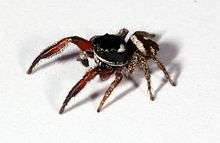Pellenes nigrociliatus
Pellenes nigrociliatus is a jumping spider species in the genus Pellenes.
| Pellenes nigrociliatus | |
|---|---|
 | |
| Pellenes nigrociliatus from Hesse, Germany in 2009 | |
| Scientific classification | |
| Kingdom: | Animalia |
| Phylum: | Arthropoda |
| Subphylum: | Chelicerata |
| Class: | Arachnida |
| Order: | Araneae |
| Infraorder: | Araneomorphae |
| Family: | Salticidae |
| Genus: | Pellenes |
| Species: | P. nigrociliatus |
| Binomial name | |
| Pellenes nigrociliatus Simon, 1875 | |
Taxonomy
Originally allocated to the genus Attus, the species was first identified by Eugène Simon in 1875 and published in a paper by Carl Ludwig Koch. It was given its current name in 1876.[1]
Description
The spider is generally black with broad white stripes across the opisthosoma. The female is larger at between 4.65 and 5.1 millimetres (0.183 and 0.201 in) long, compared to the male that is between 3.15 and 3.65 millimetres (0.124 and 0.144 in) long.[2]
Distribution
The species has been found in an area that pans from the Canary Islands, through Turkey and Israel, across the Caucasus and Russia, to Central Asia and as far as China.[1] The species is endemic across Europe, and has been identified in surveys across a wide range of countries including France,[3] the Czech Republic[4] and Poland.[5]
Synonyms
In 1999, the species Pellenes tauricus (Thorelli, 1875) was moved from being a synonym with Pellenes simoni to be a junior synonym with Pellenes nigrociliatus.[6] According to the World Spider Catalog, the species has also been described by the following species names:[1]
- Attus bedeli Simon, 1875
- Attus nigrociliatus Simon, 1875
- Attus tauricus Thorell, 1875 (later moved to Pellenes)
- Calliethera unispina Franganillo, 1910
- Pellenes bedeli Simon, 1876
- Pellenes bilunulatus Simon, 1877
- Pellenes brassayi Herman, 1879
- Pellenes nigrociliatus bilunulatus Simon, 1937
Habits
The species nests and overwinters in snail shells, such as Xerolenta obvia, that they suspend from trees.[7][8] The shells, which may weigh five or more times as much as the spider, are used to shelter from attacks by ants.[9]
References
- World Spider Catalog (2017). "Pellenes nigrociliatus Simon, 1875". World Spider Catalog. 18.0. Bern: Natural History Museum. Retrieved 23 February 2018.
- Nentwig, W; Blick, T; Gloor, D; Hänggi, A; Kropf, C. "Pellenes nigrociliatus (Simon, 1875)". Spiders of Europe. UNIBE. Retrieved 23 February 2018.
- Pétillon, Julien; Courtial, Cyril; Canard, Alain; Ysnel, Frédéric (2007). "First assessment of spider rarity in Western France" (PDF). Revista Ibérica de Aracnología. 15: 105–113. Retrieved 23 February 2018.
- Buchar, J.; Růžička, V.; Kůrka, A. (1995). "Check list of spiders of the Czech Republic" (PDF). In Růžička, V. (ed.). Proceedings of the 15th European Colloquium of Arachnology. České Budejovice. S: Institute of Entomology. pp. 35–53. Retrieved 23 February 2018.
- Rozwalka, R. (2009). "New data on the distribution of Pellenes nigrociliatus (L. Koch, 1875) (Araneae: Salticidae) in Poland" (PDF). Annales Universitatis Mariae Curie-Sklodowska. 64 (1): 117–121. doi:10.2478/v10067-010-0009-6. Retrieved 23 February 2018.
- Logunov, D.V. (1999). "A review of the genus Pellenes in the fauna of Central Asia and the Caucasus (Araneae, Salticidae)". Journal of Natural History. 33 (1): 89–148. doi:10.1080/002229399300489.
- Mikulska, I. (1961). "Parental care in a rare spider Pellenes nigrociliatus (L. Koch) var. bilunulata Simon". Nature. 190 (4773): 365–366. doi:10.1038/190365a0.
- Hula, V.; Niedobová, J.; Košulič (2009). "Overwintering of spiders in land-snail shells in South Moravia (Czech Republic)". Acta Musei Moraviae, Scientiae Biologicae (Brno). 94 (1): 1–12. Retrieved 23 February 2018.
- Hillyard, P.D. (2011). The Private Life of Spiders. London: New Holland. p. 23.